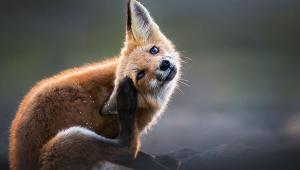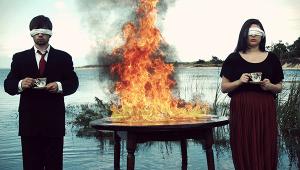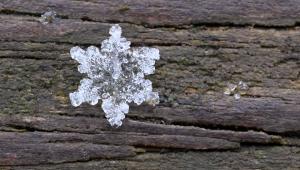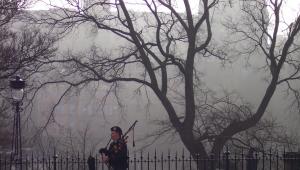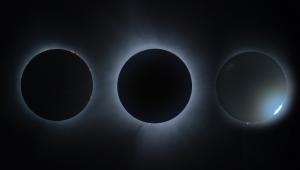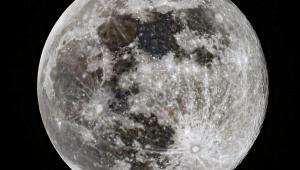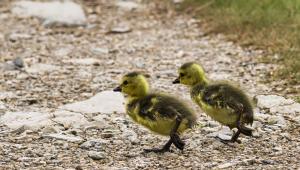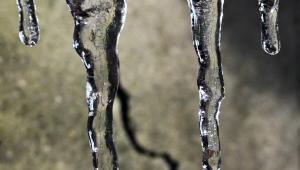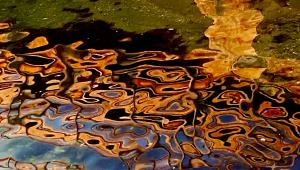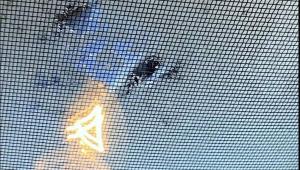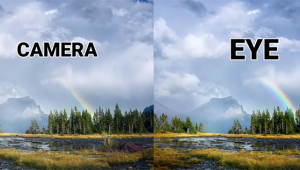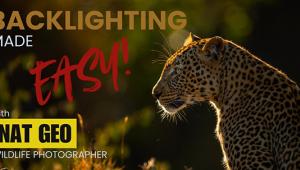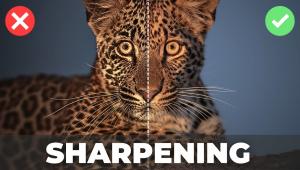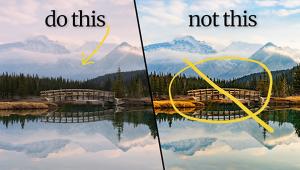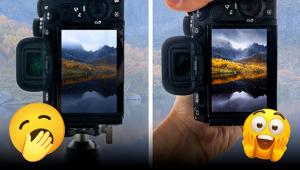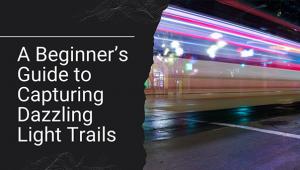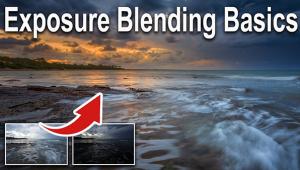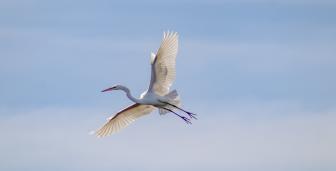The Photography Of Craig Blacklock: Man Of The Great Water
The Ojibways, inhabitants of the Lake Superior Region for some five centuries, had a name for tribal bands that lived on the south and north shores of the lake they called Keche Gumme. They were called Keche-gumme-wi-ne-wug—Men of the Great Water. If there is one non-Native American who deserves to be an honorary member of those lake dwellers, it’s nature photographer Craig Blacklock.
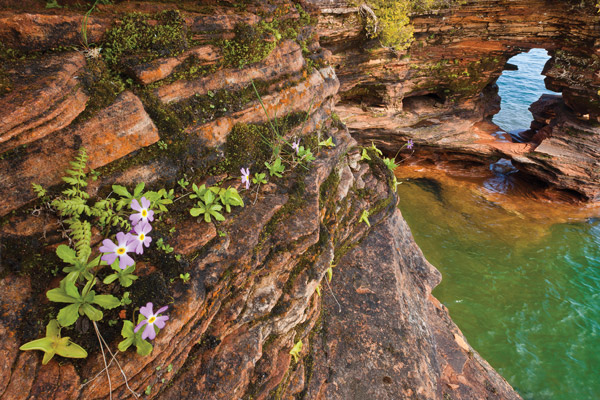
“This is one of the most complex and difficult photographs I’ve made, and also one of the most successful. The bird’s-eye primrose flowers and butterwort plants are growing on the cliffs of Devil’s Island in the Apostle Islands National Lakeshore in Lake Superior. The plants only grow in this type of environment and Devil’s Island is famous for its sea caves, arches, and windows, so I was thrilled to find a way to put both together.
All Photos © Craig Blacklock
“My first challenge was simply to get myself and my camera equipment into place without either winding up in the water. I used a 17mm tilt/shift lens to take advantage of its excellent depth of field and tilt to adjust the plane of focus. However, I wanted to be so close to the foreground that I was unable to get it all in focus in one capture. I made several captures, changing focus with each to get sharp focus throughout the whole scene.
“An additional problem—the foreground was half in direct sunlight and the wind was blowing the flowers around. So, once the camera was in place, I set up a diffusion tent—a 10x10-foot piece of white parachute cloth on fiberglass poles—over the entire foreground. This evened out the light and blocked the wind so I could make multiple captures without the flowers moving either during or between exposures. I then removed the tent, focused on the background and made one exposure for highlights and one for shadows.”
Over many years, Blacklock has spent hundreds of days in a kayak on Lake Superior photographing its mystery and majesty, much of which is accessible only by boat. One of these voyages was a 1200-mile circumnavigation of the lake. The images from this and other voyages appeared in his highly successful The Lake Superior Images (1993).
“The purpose of the circumnavigation was to connect the places I’d previously visited. I’d likely paddled more than that distance on previous trips during which the majority of the images were made,” Blacklock said. To date, the book has sold 40,000 copies. Linda Benedict-Jones, curator of the Polaroid Collection, said in her introduction: “I know of no other photographer who has celebrated one of our Great Lakes in such a thoroughly compelling fashion.” Producing such masterful depictions of the lake was no mean feat. Not only were artistic, technical, and athletic prowess required, Blacklock had to lug an inordinate amount of large format film equipment in his kayak.
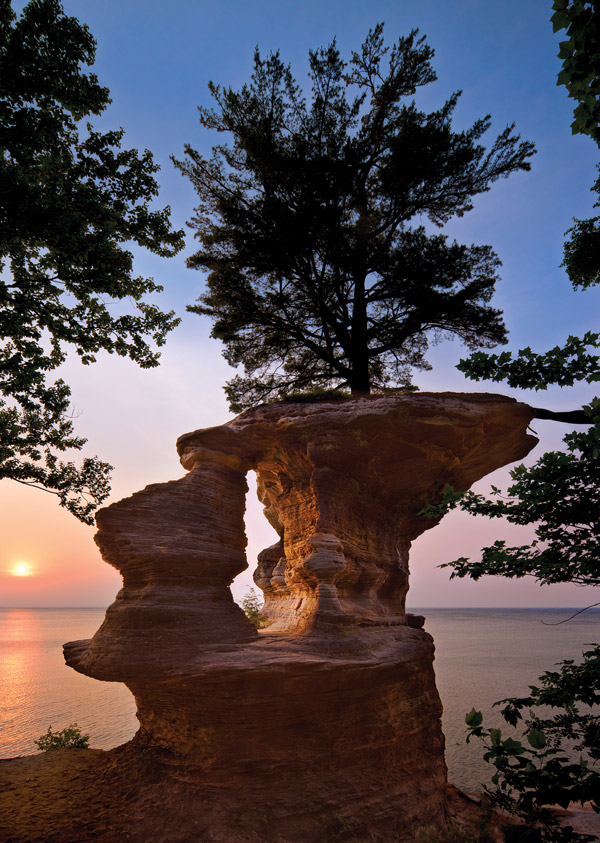
“The rock is famous for its interesting structure and the white pine growing on top. The tree is connected by a thick root on the right that crosses open space to get nourishment from the hillside just out of the frame. There used to be a land bridge across this void.
“I used my 17mm tilt/shift shifted up. Because the dynamic range of the composition exceeded my ability to capture it all in one exposure, I had to make several exposures. My first was made to capture the sun correctly without clipping. From there, I made several subsequent exposures, each with a one-stop slower shutter speed, until the darkest areas were no longer clipping on the black end.
“After doing initial editing in Adobe Camera Raw, I selected the exposures I felt I needed, output them as Smart Objects, and layered them into one Photoshop file. It is important to output as Smart Objects because, until you actually layer and apply masks, you cannot accurately gauge how bright each should be. Once I’d applied masks to reveal which area I wanted from each image, I re-opened each Smart Object and made subtle adjustments so they blended well together.”
What explains Blacklock’s almost single-minded fascination with Lake Superior? “I’m happy I’ve devoted most of my career to a single subject—especially one I’ve known my whole life. Like any long relationship, I’ve grown to know the nuances of my partner. When you work in a new area, you are wowed by the obvious. Those first images we all have made of Yosemite, Yellowstone, or the Grand Canyon most likely look pretty similar. Only photographers who have worked those areas for decades are going to be able to present work that has deeper understanding, taking us to new perspectives,” Blacklock said.
Photo Roots
Blacklock lives in the tiny Minnesota town of Moose Lake—an hour’s drive from the far western tip of Lake Superior. His father—photographer Les Blacklock—was born there and, eventually, he joined the senior Blacklock in his photographic business. “Many of my earliest recollections are of accompanying Dad on his photography trips. I learned more by osmosis than instruction. I can only remember a few times he actually gave me lessons—how to use an incident light meter, or manipulate the swings and tilts of a view camera.”
Blacklock was with his father in 1967-’68 on canoe trips he took working on The Hidden Forest (1969). “It was one of the first nature-based coffee-table books, set sales records and really started my dad’s career in books. The concept was to photograph the lichen, mosses, and abstract patterns within the forest—things many people walk by without noticing. This kind of subject matter is commonplace now, but a novelty then. Once I understood what he was looking for, I helped him find some subjects that ended up in the book,” Blacklock said.
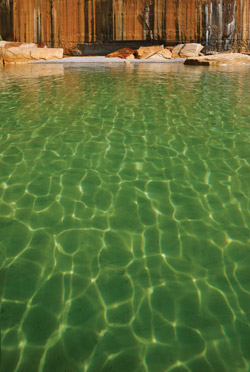
“This is a relatively simple single capture. I did tilt the 17mm tilt/shift a bit to help with focus, and shifted the lens down to keep the vertical lines from splaying out at the top. The image was made handheld from my kayak.”
The Switch To Digital
How did a landscape photographer steeped in the Zone System and accustomed to working with the resolution and tilt/shift capabilities of large format make the conversion to digital? According to Blacklock, “Digital photography has totally reinvigorated me as an artist. When I bought my first digital camera I expected it would only replace my 35mm and, possibly, 6x7 film cameras. But once I saw the quality I could get making even very large prints, I was sold. I have not loaded a sheet of film since.
“With large format film, you gained detail but had relatively small depth of field, requiring small apertures and longer shutter speeds. With digital, I had the detail of medium format film, smooth linear gradation of tones, incredible depth of field, and the ability to change ISOs as needed.”
Blacklock said that, for the most part, he still approaches subjects with the deliberate process he used with the view camera. Unless in a boat, he’s always on a tripod. But now he’s more likely to make several captures that will be combined into the final image, either to extend focus, dynamic range, create panoramas, or any combination of the above.
According to Blacklock, digital images have the ability to mimic human visual memory. In scanning a scene, our eyes are constantly refocusing and irises opening and closing so we see each detail properly focused and exposed. We only see a bit at a time, but the mind combines all of these bits in our visual memory. In this sense, it’s actually the brain that “sees,” not the eyes.
“A well-done digital image does exactly the same thing. The photographer gathers the components, each capture having a portion that is optimized. Then that stack of captures is processed so, when combined, 100 percent of the frame is properly focused and exposed—a mosaic created seamlessly from all of the original captures,” Blacklock said.
One thing Blacklock didn’t leave behind in his conversion to digital is the use of tilt/shift lenses.
His favorite? A 17mm tilt/shift. “I love working with wide angles, incorporating very close foregrounds into
my landscapes. The tilt allows me to control the plane of focus to get even closer to my foreground in a single capture, and the shift can be adjusted to keep parallel lines straight,” he said.
For extended focus, Blacklock makes several captures at different focus points, does all normal correction of each image, and then saves them as TIFFs that are fed into Helicon Focus software. The software automatically transforms the scale of the images, aligns them, selects the sharpest pixels from each capture, and outputs a final, flattened image which is sharp throughout.
For extended dynamic range (HDR), Blacklock typically works manually rather than using software. He makes several captures at different exposures to cover the dynamic range of the scene from brightest to darkest with no clipping. He makes corrections to the Raw files in Adobe Camera Raw, treating them identically.
If both dynamic range and depth of field requirements exceed what he can get in a single capture, Blacklock applies both techniques. He starts in the foreground, correctly focusing and exposing for it, then moves back one depth of field zone, or to the next exposure adjustment needed, again focusing and exposing optimally for that zone. He proceeds in this fashion to the back of the composition. After doing adjustments to the Raw files, Blacklock loads them from Bridge into Photoshop Layers for auto-alignment. He then adds masks and selects areas of proper focus and exposure manually.

“Here I’ve tilted the lens to align the plane of focus with the plane of the subject. The direct sunlight on the bunchberries was too contrasty, and there were distracting tree shadows as well. I set my self-timer to 10 seconds, tripped the shutter, and hurried to hang my tent over the cliff edge to diffuse the foreground light. I later blended this with one made without the tent, balancing the feeling of soft-direct sunlight on the background.”
An Artist’s View
“I’ve always felt that a visual artist’s work should stand on its own, without the aid of further explanation. I create my photographs as a personal statement about how I feel about my subject matter. That said, I try to utilize them as catalysts to get others to help protect our planet, and, in particular, the wild landscapes of Lake Superior.
“Nature photographers are often on the front lines, witnessing nature being consumed by condo developments, the effects of overpopulation and climate change. The traditional response of trying to save one ecosystem or one species at a time is being replaced by a larger emergency—the need to save the viability of the planet,” Blacklock said.
Craig Blacklock’s Photo Tips
1. The slower you go, the more you accomplish. That is probably the most important tip I can give any photographer. Often people think they need to make dozens of images in a day. At least in nature photography, you can’t possibly find that many things worth photographing. I’ve made my living for over 35 years averaging about three setups a day, but make prints or publish from a very high percentage of those. I spend much more time looking and thinking than actually working with the camera.
A good way to slow down and compose more critically is to use a tripod. The digital techniques I use demand the use of a tripod, but, even if not, the simple act of setting the camera on the tripod slows you down, giving extra time to see what you are photographing and to fine-tune variables within your control. Then make an image and walk away for a few minutes. When you come back, look at the image in your viewfinder as if seeing it on the wall. Often, a fresh view will reveal mistakes or suggest other approaches.
2. Get up early. Figure out what time you should be in place for morning light. Morning, in almost every ecosystem, is by far the best part of the day for photography. You don’t want to be stressed, hurried, or, worse yet, miss a great shot because you hit the snooze button.
If possible, plan your photograph the day before—where will you be, what lens will you use, where and when the sun will come up. My dad was a great midday napper, and I’ve inherited that trait. When the workday starts at 4:30am, it makes sense to catch up on sleep when the sun is high.
3. Make every capture count. With memory cards holding a seemingly infinite number of captures, there is a tendency to make lots of images, hoping something will work. But your chance of having random success with hundreds of captures is much lower than by making a few well thought-out exposures, each with a distinct purpose.
Craig Blacklock’s Gea
Camera: Canon EOS-1Ds Mark III
Canon Lenses: 17mm tilt/shift, 24mm tilt/shift, 45mm tilt/shift, 90mm tilt/shift, 180mm macro, 28-300mm L IS USM—primarily used when hand holding in his kayak
Tripod: Manfrotto 3221WN
Diffusion Tent: Custom sewn from parachute cloth—10x10 feet with three 10-foot, shock-corded poles
Software: Adobe Photoshop, Bridge, and Adobe Camera Raw (ACR); Photomerge for panoramic images; Helicon Focus (HeliconSoft.com); Perfect Resize 7.0 Professional Edition (OnOneSoftware.com—to interpolate images to larger sizes)
Craig Blacklock has published 17 books, his latest being Apostle Islands (2012) and Pictured Rocks (2012). More information about Blacklock’s workshops, exhibits, books, and images is available on his website at: www.blacklockgallery.com.
- Log in or register to post comments











